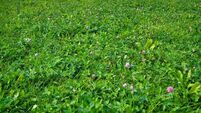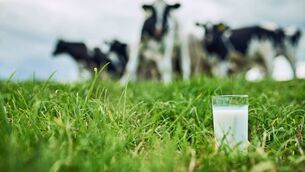Preparation is key for excellent silage
IT has been a good year for grass growth. A lot of silage is already made, and the bulk of the first cuts will be finished in the coming weeks.
Preparation is essential for best results, and is the key for farmers who make excellent silage every year (75 DMD+).
Poor quality silage will result in poor animal performance and serious economic effects during the feeding period and long afterwards.
For example, poor quality silage can reduce milk production by one gallon per day, and often results in cows calving in poor condition, with increased fertility problems and replacements falling far short of optimum targets, unless a lot of expensive concentrates are fed.
Weather and contractors can take some of the blame for poor quality silage. However, there are other reasons.
The first essential for top quality silage is very often lacking — to have a good quality, clean, ryegrass crop, properly fertilised.
Many crops are allowed to overgrow and lodge badly. Other farmers close up silage ground too late in April, resulting in very stemmy material. The role of additives, where required, is often ignored, and very often, inadequate preparations are made for the harvesting operation.
Alternative forages:
Because of unsatisfactory performance from grass silage, some farmers changed to maize silage or other forage crops. But farmers who cannot make good quality grass silage are unlikely to be successful with alternatives. Maize and other crops are excellent feeds, but grass silage, especially first cuts, will remain the cheapest and most suitable source of winter feed on the vast majority of spring calving dairy farms.
Preparation: Silage pits should be well washed out and any cracks sealed.
Proper facilities should be provided for effluent, which can vary from 10 to 50 gallons per tonne of grass, depending on the dry matter of the material being ensiled.
Silage harvesting is very expensive. However, it is generally cheaper to use a reliable contractor rather than provide your own equipment. Book well in advance of harvesting.
A suitable alternative to contractors in some areas might be a few farmers co-operating in the purchase of a pick up-wagon.
A clean grass pick-up area should be provided.
Crops should be regularly checked for signs of deterioration at the base, or heading out. Before harvesting, a sample should be tested for ensilability.
The technology of silage making has changed very little over the past few decades.
A good quality crop of ryegrass is the first essential. However, this is no guarantee of good quality silage. If harvesting is delayed, or if crops are badly preserved, performance will be reduced. Poor quality grasses have low feeding value, and are difficult to preserve because of their low sugar content. Some farmers are going for later, heavier crops. However, where crops lodge, this is not a suitable option, because a lot of rotten, useless material has to be harvested. Lodging also has a very bad effect on sward recovery, and damages the grass. High yielding cows need good quality silage during the dry period so that they calve down in proper condition. Replacements also need high quality silage.
The DMD value of silage is the best indicator of its feeding value. Silage yields can increase by up to two tonnes per acre per week, and DMD declines by more than two units of DMD per week in late May and early June.
DMD decreases by about three units per week after grass heads out, and up to double this rate if crops are lodged. Poor fermentation can decrease DMD by as much as seven units. Ryegrass is two to four units higher for DMD, and is easier to ensile than poorer type grasses.
Each drop of five DMD units reduces milk yield by almost half a gallon of milk per day, and increases the cost of finishing beef cattle by more than 50.
The ideal time for silage harvesting is when the crop is heading out — but this is difficult to judge in a crop with mixed species of grass.









